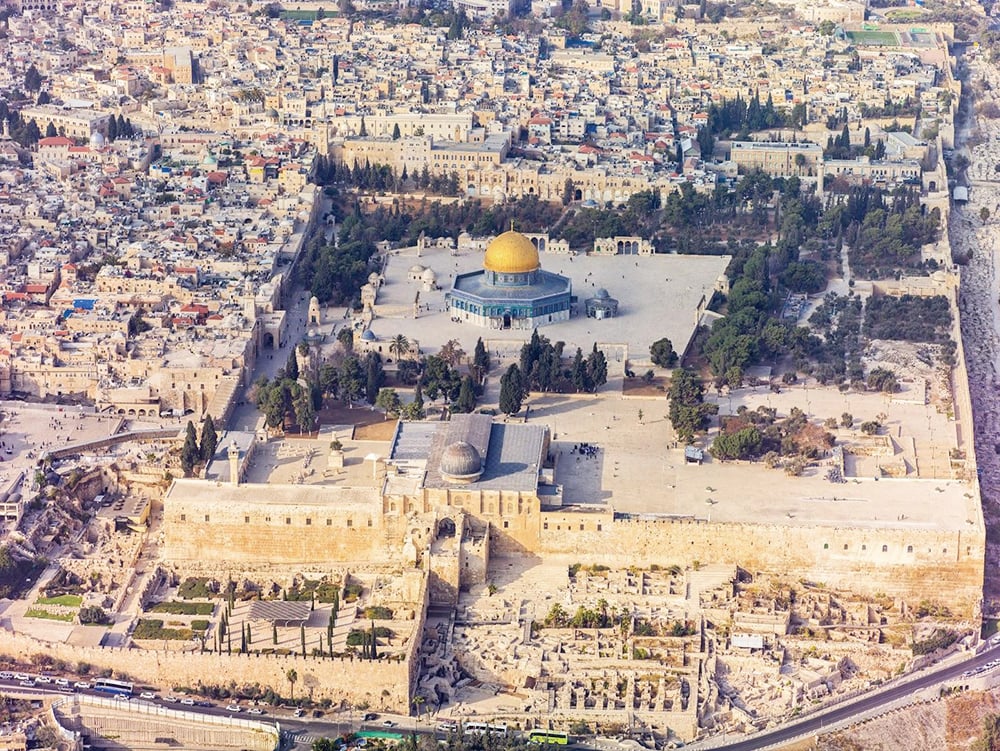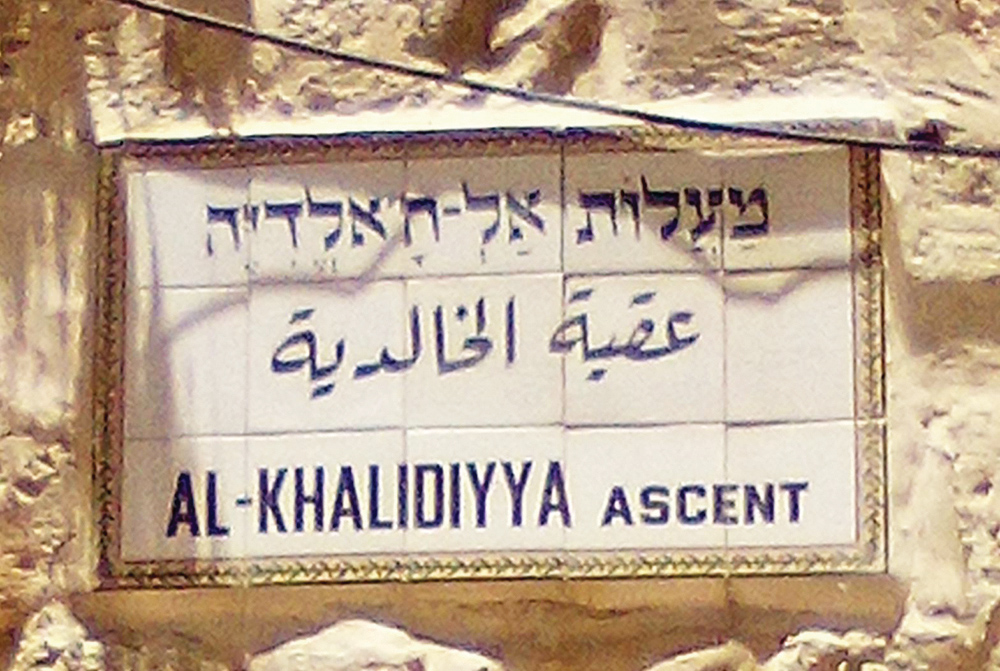
Did you know: The Jewish Quarter occupies just 15% of the Old City and is smaller than the Temple Mount?
When touring the Old City, many people visit the Kotel and other sites in the Jewish Quarter (“Rova”). However, these people
miss out on 85% of the Old City. The Jewish Quarter occupies just 133 dunam (~33 acres) of the Old City’s 870 dunam (~215 acres), or a bit more than 15% of the city.
Why are other parts of the Old City often avoided? I believe it is because the other quarters are labeled as “Christian” or “Muslim” for example, and therefore Jews believe these areas hold little importance to their heritage.
Over the next few minutes, I will debunk this Old City myth by explaining who created the quarters, how their names do not accurately reflect their histories, and why all four quarters are a “must-see” for anyone who wants the full story of the Jewish history (and the Jewish future) of the Old City.
What’s in a Name?
A name often tells of a subject’s essence (see Brachot 7b). But this is only true if the name is given intentionally. Before creating an Old City itinerary based on its so-called “quarters,” it is logical to first determine who created these “quarters.”
The first map to include names that resemble the names of today’s four quarters (Armenian, Christian, Muslim, Jewish) was produced by British lieutenants Edward Aldrich and Julian Simmonds in 1841, and later labeled by Rev. G. Williams in 1849 (Teller, “Nine Quarters of Jerusalem,” pp. 32-33, 36). However, some of these names (Christian and Armenian) already appear in European travelers’ writings in 1806 (Tobler, “Denkblätter,” pp. 121-126, and quoted in Ben-Aryeh, “Jerusalem in the 19th Century” (Vol. I, The Old City, p. 14).

How Did These Quarters Come to Be?
Hebrew University Prof. Yehoshua Ben-Aryeh suggests that each religious group to move into the Old City built its community around focal points significant to its religion. Once a specific area held the majority of a group’s population it became known as the group’s “Quarter” (Ben-Aryeh, pp. 155, 219, 243, 316).
Therefore, the quarters did not determine exclusive rights to an area; rather, they provided a convenient way to refer to different sections of the city.
To understand the gravitation of religious sects to specific areas of the city, the focal points as presented by Ben-Aryeh are reviewed below.
Old City Focal Points: Muslim, Christian and Armenian Quarters
The Old City population from the beginning of the 19th century until today has varied greatly. Therefore, although groups initially formed a community around a particular nucleus, over time some communities shifted locations or expanded in size. These changes make the borders of some quarters difficult to pinpoint.
For Muslims, the Temple Mount, which houses the Dome of the Rock and Al-Aqsa mosque, served as a major force of attraction. Muslim schools, religious centers and government buildings were built close to walls of the Temple Mount; some buildings even used a wall of the Temple Mount as their fourth wall. However, Muslims did not build homes on the Temple Mount because of reverence for the site.
While the Muslim Quarter today roughly resembles the Muslim residential area of the 19th century, there is one area that no longer exists: the Mughrabi neighborhood. Descendants of the North African Muslims expelled from Spain in 1491 settled there. This plot of land was converted into the Kotel Plaza after Israel captured the Old City from Jordan in the Six-Day War.
The Christian community took root around the Church of the Holy Sepulchre. At the same time, several Christian sites were either built or renovated along the Via Dolorosa, a street that extended into Muslim populated districts. Therefore, while that area is known as the Muslim Quarter, one may say that it is really an extension of the Christian Quarter or an area shared between Christians and Muslims.
Armenians, many of whom were Christian, were drawn by the Church of St. James, their most significant church in the Old City. The scope of the Armenian quarter is elusive, some defining it only as a certain walled-off area that was locked at nights (see Ben-Aryeh, p. 243).

Old City Focal Points: Jewish Quarter
Due to large population fluctuations, it is difficult to define the borders of the Jewish Quarter.
Initially, the Jewish Quarter spanned from the “Street of the Jews” (Rechov haYehudim) eastward to the Western Wall (excluding the adjacent Mughrabi neighborhood). Some suggest the Jewish Quarter’s proximity to the Western Wall and its view of the Mount of Olives pulled Jews to the area. Others believe Jews settled here because Ramban built a synagogue nearby in 1267.
At the beginning of the 19th century, the Jewish quarter was almost entirely comprised of Sephardic Jews, with some 2,200 Sephardic Jews and a minimal amount of Ashkenazim. Once Ashkenazim began moving in, they chose to settle near the Sephardim, holding their services in several Sephardic synagogues, including the Beit-El synagogue, until the Ashkenazic community built the Menachem Tzion synagogue in 1837 (Ben-Aryeh, p. 299).
A 6.8 magnitude earthquake that devastated Tzefat and Teveria in January 1837 ushered mass immigration to the Old City. In 1836, about 3,250 Jews lived in the Old City; by 1840, almost 5,000 Jews lived there, mainly in the Jewish Quarter (Ben-Aryeh, p. 279).
Residential overcrowding and the rise in price of Jewish Quarter real estate were key reasons that led Jews to move away from the Quarter’s nucleus. In the 1850s, many Jews moved to Chabad Street to the west and Hebron Street (known today as al-Khalidiyya Ascent in the Muslim Quarter) to the north.
Hebron Street became such a popular location for Jewish residents that a census by the World Zionist Organization during World War I showed more Jews living on Hebron Street than the combined number of Jews living on the Street of the Jews and Chabad Street – the two main streets of the Jewish Quarter (Palestine Office, Censi, I, Judaea, p. 5). Therefore, some suggest that Hebron Street was part of the Jewish Quarter at the time (Ben-Aryeh, p. 386).
Then and Now: Jewish Relevance in the Muslim and Christian Quarters
Jewish life in the Muslim Quarter expanded well beyond Hebron Street.
Much of today’s Muslim Quarter was once a vibrant hub of Jewish life. More than 50% of the stores in the Old City’s various shuks were owned by Jews, including the Schorr Winery owned by Rabbi Yitzchak Schorr, whose descendants run today’s well-known 1848, Zion and Jerusalem wineries.
Many of the previous generation’s secular and Torah leaders grew up or studied here. For example, Eliezer ben Yehuda grew up on Hagai Street in the courtyard of Rabbi Menachem Mendel Rand of Sanz. That same street hosted the Torat Chaim Yeshiva, located about halfway between the Kotel and Sha’ar Shechem (Damascus Gate). The yeshiva’s star students included Rav Tzvi Pesach Frank, Rav Aryeh Levin, and Rav Tzvi Yehuda Kook.
The so-called “non-Jewish” quarters are not just a relic of historic Jewish life but also the grounds of a blossoming community. Today’s Muslim and Christian quarters are home to about 950 Jews, including 90 families and four yeshivot.
Breaking Stigmas
Don’t let their names fool you. As a result of the late 19th century Old City Jewish population boom and Jewish activity in the area over the past 40 years, there is a lot for Jews to see in the Muslim and Christian Quarters.
If an Old City visit seems like the same attractions over and over again, it is time to explore the other 85% of the city. A complete picture of the Old City’s Jewish past, present and future can only be appreciated by visiting all relevant areas of the Old City — even those that do not include the word “Jewish” in their names.
Shlomo Deutsch grew up in Teaneck and now lives in the Old City. In his free time he enjoys learning from his students at Aish HaTorah and interacting with the many characters of the Old City. He recently launched Old City New Story, a project that focuses on the Old City’s less known attractions (especially Jewish sites in the Muslim Quarter) to make us feel more connected to Yerushalayim. He wishes to share his Old City passion with you and can be reached by email at [email protected].









